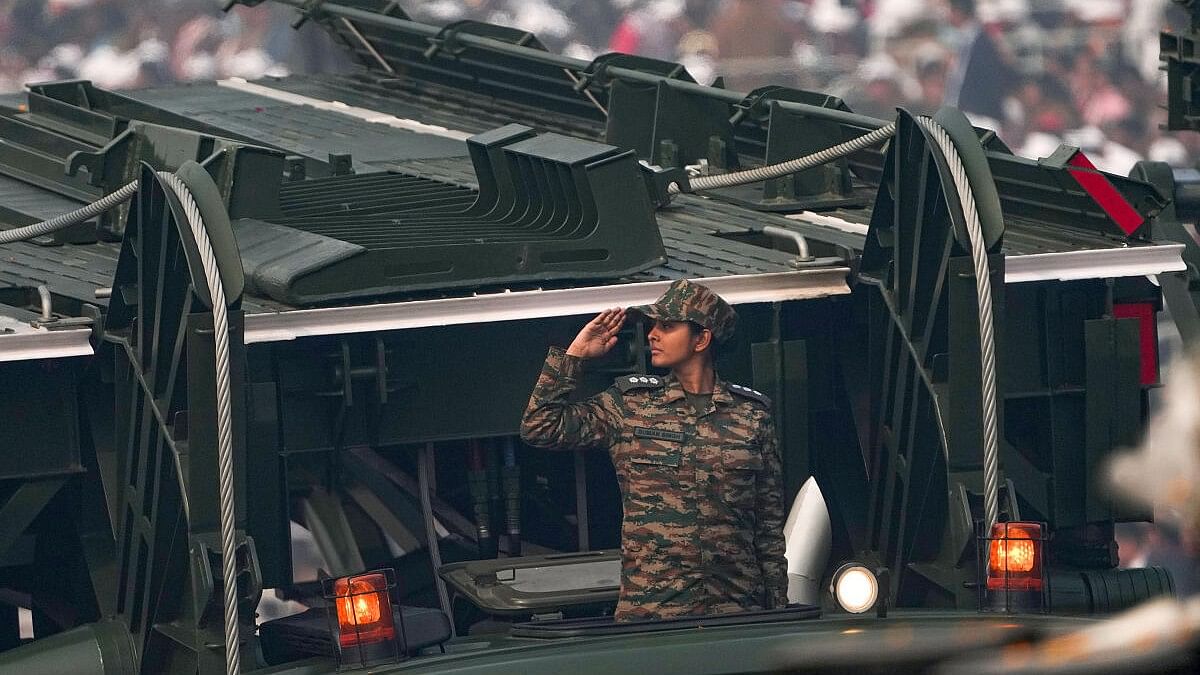
Indian Army's 'Sarvatra Mobile Bridging System' during the 75th Republic Day parade.
Credit: PTI Photo
The Republic Day Parade on Kartavya Path in New Delhi on January 26 showcased India’s cultural diversity, women power, and military strength. The occasion was also a tacit display of efforts to indigenise India’s military hardware in line with the Aatmanirbhar Bharat (self-reliant India) slogan, which now defines India’s defence production and weapons acquisition programmes.
The missiles, radar systems, and weapons platforms such as the Main Battle Tank Arjun, K-9 Vajra howitzers, and Nag anti-tank guided missiles which rolled past the saluting dais represented India’s homegrown defence capabilities. The Ministry of Defence (MoD) decided to include only indigenously produced systems in the parade — and even the customary 21-gun salute this time was fired from 105 mm Indian Field Guns developed by the Ordnance Factories Board (OFB).
This reflects the confidence of a nation ready to shrug off the tag of being a net importer of weaponry, and realise its potential of becoming a global defence manufacturing hub. It intends to do this by promoting indigenous manufacturing, while simultaneously cheerleading foreign original equipment manufacturers (OEMs) to set up shop in the subcontinent. The idea of acquiring Indigenously Designed, Developed, and Manufactured (IDDM) platforms now echoes in the corridors of the MoD, and is the new ‘normal’ for the armed forces. Industry players have become key stakeholders in this with the private defence manufacturing sector undertaking projects denied to it till recently.
Curiously, India did have a rudimental defence industrial base for almost 90 years, but it operated on ideas which suited the needs of the British Indian Army during World War II. Later, even after India nationalised its 220-year-old OFB to oversee all defence production, a big question mark hung over its performance and efficiency.
It was only in 2021 that New Delhi decided to bite the bullet and restructure the 41 factories of the OFB as seven separate Defence Public Sector Undertakings (DPSUs): Advanced Weapons and Equipment India Limited; Armoured Vehicles Nigam Limited; Gliders India Limited; India Optel Limited; Munitions India Limited; Troop Comforts Limited and Yantra India Limited).
Shorn of the lengthy red tape which hamstrung the OFB earlier, the new DPSUs could hit the ground running, bringing in much-needed innovation and forging partnerships with industry to boost indigenous manufacturing. This is encouraging private players to step into a space that was off-limits for them till recently and gain expertise in developing new-age weapons systems for the three services. Tata Advanced Systems Ltd and Bharat Forge, for instance, have joined hands with the DRDO to design and produce state-of-the-art towed howitzers. Such tie-ups not only help private industry gain new expertise on frontier technologies, but also provide a chance to contribute to the MoD’s decision-making process.
The guiding philosophy of all major militaries in the world is to beware of obsolescence creeping in on their core combat capabilities and the Indian armed forces are no exception. To achieve this objective, the Defence Planning Committee, set up in 2018, made indigenisation in the defence sector a priority while addressing the military’s capability development needs. Following this, its Defence Acquisition Procedure (DAP) emphasised the military exclusively acquiring indigenously-produced arms. The DAP of April 2022 hails the ‘Buy Indian-IDDM’ category which recommends the ‘acquisition of products from an Indian vendor that have been indigenously designed, developed and manufactured with a minimum of 50% Indigenous Content (IC) on cost basis of the base contract price, i.e. total contract price less taxes and duties in consonance with the Defence Capability Development Strategy.”
Private participation in the defence sector in the three financial years from 2018-2019 to 2021-2022 has been remarkable: during this period, private vendors cornered 72 deals from a total of 127 capital acquisition contracts signed with the erstwhile OFB, DRDO, and PSUs. The Strategic Partnership Model (SPM) is a good example of this. It helps Indian companies form joint ventures with foreign OEMs to make military hardware in India along with technology transfer. The SPM’s ambit includes fighter aircraft, helicopters, submarines, and armoured fighting vehicles.
With robust backing from the government, the armed forces should be able to draw from a steady supply of homegrown defence technologies sooner rather than later. The MoD’s Innovations for Defence Excellence (iDEX) scheme is a good example: it encourages MSMEs, startups, innovators, research and development institutes, and academia to foster innovation and technology development in the defence and aerospace sector. iDEX assesses the new technologies developed and helps the military adopt them. Similar schemes include the Technology Development Fund which enables MSMEs and startups to design and develop various defence technologies and the DRDO’s Dare to Dream Innovation contest which helps startups become a part of the defence ecosystem.
Measures like these, along with increasing foreign direct investment (through the direct route) to 74 per cent, have already shown results with the value of defence production in 2022-2023 crossing the figure of Rs 1 lakh-crore for the first time ever.
If the MoD persists with this synergistic approach to arms manufacturing, India is on the right path towards becoming a world leader in the global defence industry market.
(Prakash Chandra is former editor of the Indian Defence Review. He writes on aerospace and strategic affairs.)
Disclaimer: The views expressed above are the author's own. They do not necessarily reflect the views of DH.